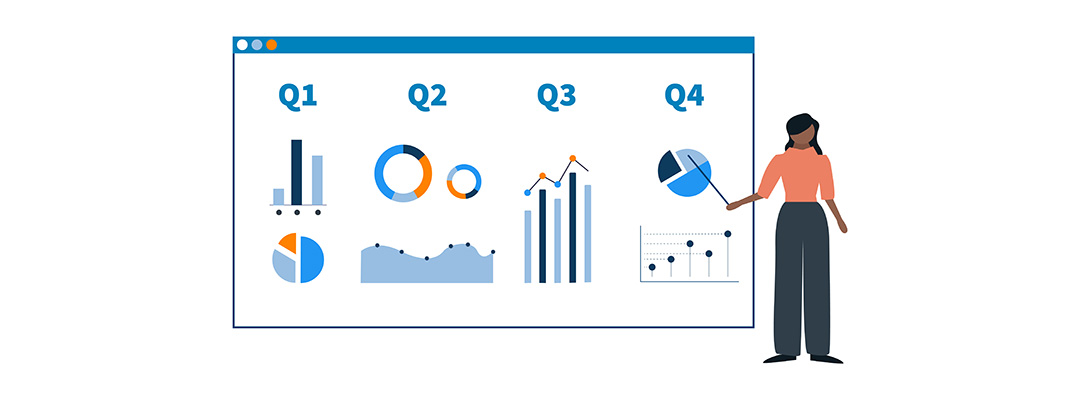An important element of budgeting – not only in IT and Shared Service Management – is cleverly utilizing regular forecasts over the course of the year. Even the best budget planning cannot be prepared for each and every unexpected crisis – surely no CIO could predict the impact that COVID-19 would have on the world economy – and effective forecasting allows you to work with difficult situations by enabling budget adjustments, damage avoidance, and the leveraging of hidden potentials. While in this article we will mainly focus on the area of ITFM, the principles discussed here can be extended to the performance management of the entire enterprise as such.
What are Forecasts?
A forecast is a planned/actual comparison during the course of a fiscal year, wherein the budget plan from the beginning of the year is contrasted with actual numbers (at the time of any given forecast) and where a projection on the budget needed for the rest of the budget cycle is given. Based on this, you can make predictions as to whether planned budget targets for the year will be met or not. Forecasts can be done biannually, quarterly, or even monthly and allow for a precise analysis of budget developments. In case a forecast significantly deviates from the budget plan, you can make short-term adjustments to optimize the plan for the rest of the year.
An example: At the beginning of the year, the budget plan listed 10 new SAP users for IT. However, in the biannual forecast you see that this year’s IT requirements are already met by adding only 8 new SAP users. Now that there is newly freed up and identified budget, these resources could be re-allocated towards an innovation project that had been underfunded until now.
The higher the level of standardization and automation of your budget planning and forecasting is, the more flexibility you have to make short-term adjustments and get everything you can out of your budget.
The 3 Dimensions of a Forecast
In the realm of IT and Shared Services, forecasts are generally analyzed and evaluated alongside three dimensions: changes in unit amount, changes in production cost, and changes in the service offering. In the following, we will have a more detailed look at these three dimensions.
1. Change of unit amount
This dimension was discussed in our example above. The quantity of a required service or product in the forecast does not align with the amount that was set in the original budget plan, e.g. instead of 10 SAP licenses, you only required 8. This freed up some of your budget, which can now be allocated elsewhere. If you imagine this example playing out the other way around – i.e. you needed bigger quantities than originally planned – you then instead would have to see whether and where you can realize short-term savings to not go over budget.
2. Changes in production cost
This dimension looks at products and services from the opposite end of the aisle. The unit amount of (IT) services might stay the same, however, over the course of the year the procurement or production costs of a service have changed. Have they gone up? It might be a good idea to re-evaluate whether the planned unit amount aligns with actual necessity. Have they gone down? Now you can decide whether you might want to purchase said service in a higher quantity or rather reallocate the saved-up budget somewhere else.
3. Changes in the (possible) service offering
This dimension operates on a slightly different level than the unit amounts or production costs. It is less about how many services/products are used at what cost, but rather which IT and shared services you yourself can provide to your departments and customers and furthermore, which projects you can invest in. One good example here is the impact that COVID-19 had on the market: many enterprises were (and still are) forced to make major changes and concessions to their usual service offering. Organizers of big events had their hands tied by the necessary health regulations which lead to a noticeable shift to alternative event formats like webinars and digital roundtables. A change like this is likely dependent on a completely different set of requirements when it comes to IT and shared services, which in turn is a considerable influence on the forecast.
What do I do with these forecasts now?
If you have gathered and analyzed your forecast data, it is a question of the proper controlling to draw the right conclusions and support management with effective courses of action. We already discussed various possibilities in our examples above: Adjustments to the unit amounts. Re-allocation of freed up budget. Restructuring of the service offering. The more thorough and automated your forecasts are and the more flexibility you have in your controlling efforts, the better the decisions you will make for your budget adjustments. One helpful tool towards achieving this, is tailor-made software for financial management.
Forecasts with Serviceware Financial
Our own software for financial management of IT and shared services - Serviceware Financial - offers specialized functionalities for planning, forecasting, and controlling. One particularly powerful tool here is the so-called scenario planning. Based on existing budget plans, you can create virtually infinite plan scenarios that you can use to simulate different changes (e.g. to the unit amounts needed) and see how that could affect your budgeting. Based on these scenarios and your budget plan, Serviceware Financial can automatically create regular forecasts which can then be compared to the plan scenarios. Planned/actual comparisons and forecasts are technologically linked in the software, meaning the forecast scenarios “inherit” data from plan scenarios. These plan scenarios then are fed and overwritten with the new data from the actuals, leading to an automated, rolling, monthly forecasting, offering you a maximum of flexibility.

 German
German

